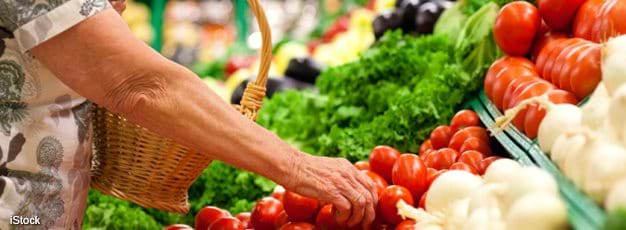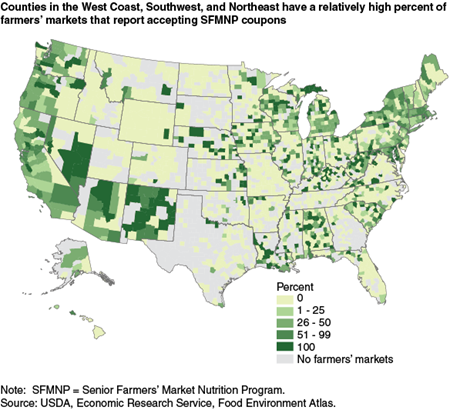Food Assistance Program Connects Low-Income Seniors with Fresh Farm Produce

The 2014 Farm Act reauthorizes the Senior Farmers’ Market Nutrition Program (SFMNP) with mandatory annual funding of $20.6 million through fiscal 2018. The SFMNP provides low-income seniors—people age 60 and older whose household incomes are at or below 185 percent of the Federal poverty level—with coupons to buy fresh fruits, vegetables, and other local foods at farmers’ markets, roadside stands, and community supported agriculture (CSA) programs. The SFMNP is a relatively young food and nutrition assistance program that began with a pilot program in 2001.
The program operates through grants to States, U.S. territories, and federally recognized Indian Tribal Organizations (ITOs). State agencies, such as State Departments of Agriculture or Departments of Aging, and ITOs, issue coupons to eligible seniors. In fiscal 2013, 51 State agencies and ITOs received grants that provided 835,795 low-income seniors with SFMNP coupons. The benefit amount per participant is typically between $20 and $50 each year, although State agencies may also supplement the benefit level using State, local, or private funds. SFMNP coupons allow the purchase of unprocessed fruits, vegetables, honey, and fresh-cut herbs, but exclude certain other products such as dried fruits, potted fruit or vegetable plants, cider, maple syrup, and molasses. State agencies also make nutrition and food preparation education, designed to encourage consumption of fresh produce, available to SFMNP participants.
State agencies and ITOs authorize individual farmers, roadside stands, farmers’ markets, and CSAs to accept and redeem SFMNP coupons. According to USDA’s National Farmers' Market Directory, of the 8,158 farmers’ markets in the United States in 2013, a total of 2,330 reported accepting SFMNP. However, the proportion of SFMNP-accepting markets varies widely across counties; in 396 of the 3,007 U.S. counties, over half of farmers’ markets reported accepting SFMNP coupons, and in another 295 counties, 26 to 50 percent of farmers’ markets reported accepting SFMNP. Of the counties with no SFMNP-accepting farmers' markets, 42 percent did not report having a farmers’ market in the Farmers' Market Directory. Possible barriers to markets’ acceptance of SFMNP benefits as a form of payment may include lack of familiarity with the program on the part of farmers’ market managers or their assessment that not enough low-income seniors would frequent the market.
Areas in the Northeast, Southwest, and along the West Coast tend to display a relatively high percentage of farmers’ markets that accept SFMNP coupons. Not surprisingly, the percent of farmers’ markets that accept USDA’s Supplemental Nutrition Assistance Program benefits displays a similar geographical pattern.
Food Environment Atlas, by Alana Rhone, USDA, Economic Research Service, April 2024


